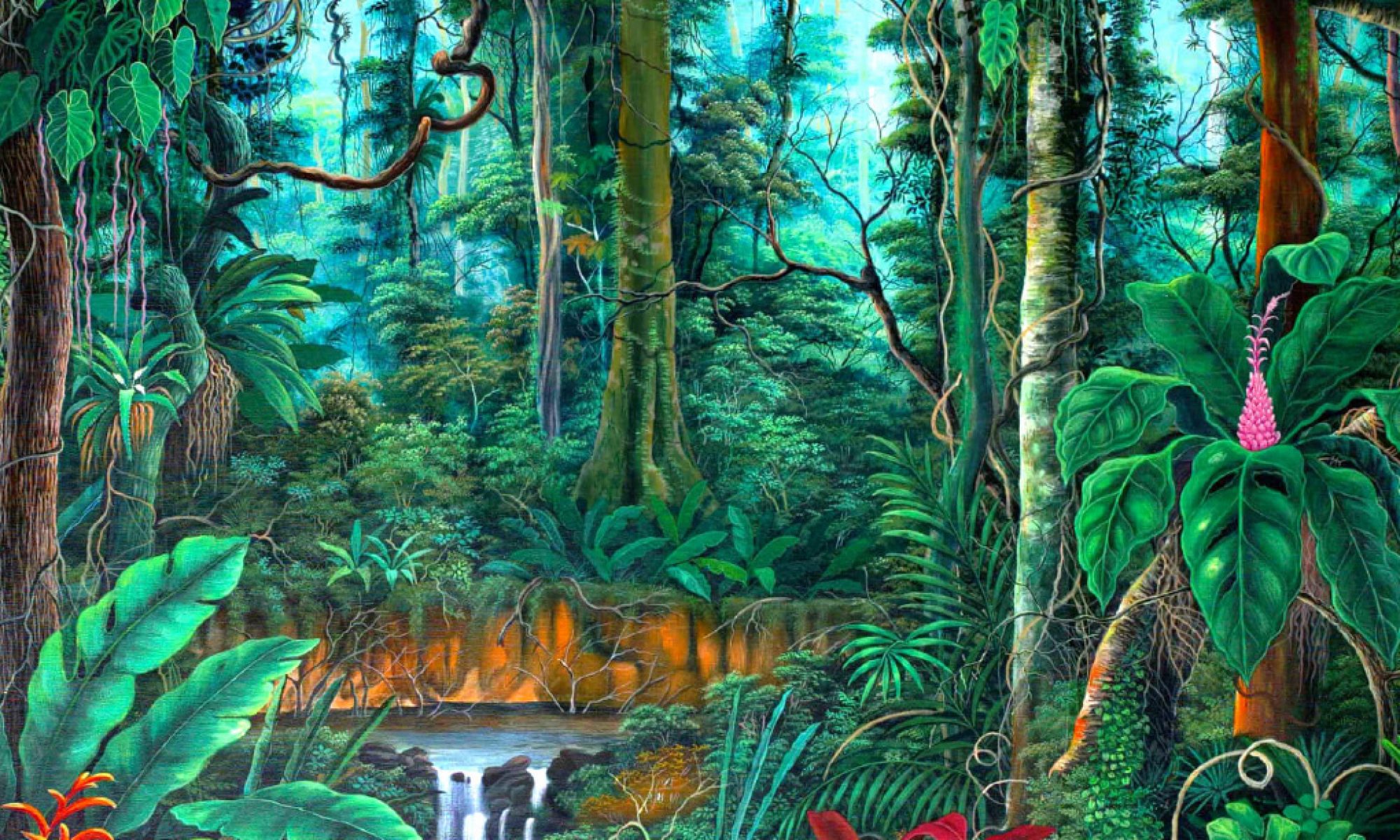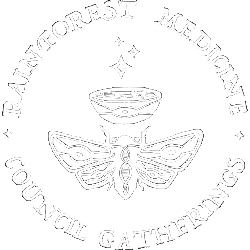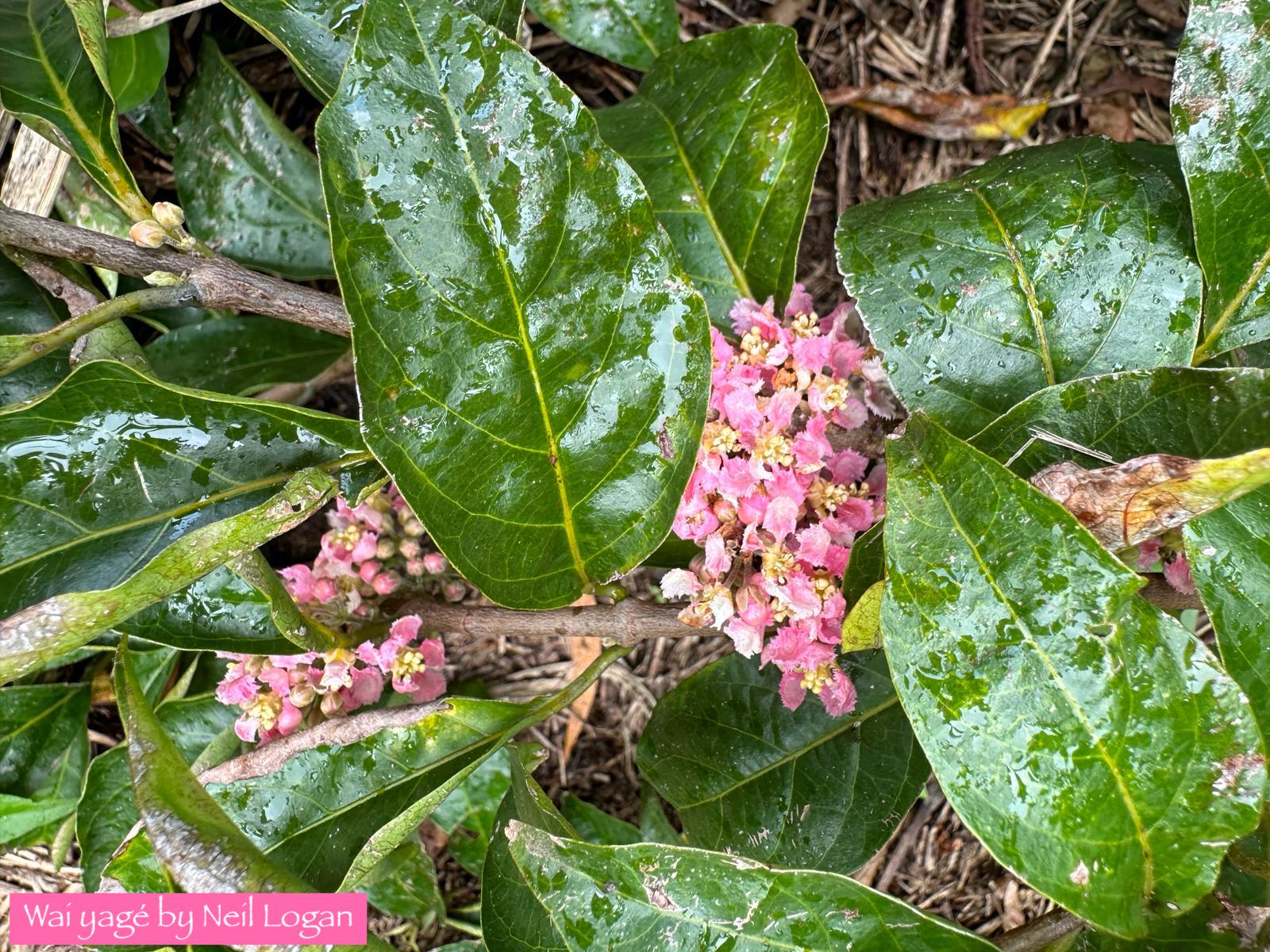Dedicated to Miguel Payaguaje and his extended family (including his father Delfín and his grandfather Fernando), as well as all the vine gardeners responsible for stewarding these sacred plants through time.
Note: This article was originally published on Microcosms, A Home to Sacred Plants of the Americas. It has been republished here with permission from the author.

Introduction
This essay will present the origins, evolution, and human co-history of the Malpighiaceae family of ethnomedically significant vines in order to shed light on the confusion and controversy surrounding these important taxa. The intention is to draw attention to the importance of preservation and support of the indigenous cultures that continue to have deep connections with these sacred plants before this knowledge is gone. Images created with the confocal microscope of these species are featured in the website Microcosms: A Homage to Sacred Plants of the Americas.
Origin of the Malpighiaceae Family
South America separated from Africa around 100 mya. The Malpighiaceae family of plants originated in South America approximately 70 mya. The family has roughly 77 genera containing approximately 1300 species, ranging in form from vine, tree, or shrub. 88% of the genera are from the new world with 22% escaping to the old world. Quite a feat considering South America and Africa had been split apart for ~30 million years before this family was born. (See Davis et al and Davis and Anderson)
Ecology and Fruit
Many of the vines in this family function ecologically as pioneer and accumulation species that help promote soil fertility by rapidly colonizing open sunny areas and degraded sites. They climb to the tops of tall trees in search of sunlight. Eventually, they can become so heavy that the host tree collapses under the weight, thereby creating gaps in the forest canopy. When a vine reaches the treetop, it is perfectly located for reproduction. Once the flowers are pollinated, the resulting fruits, when dry, are shaken by wind and released, sending them helicoptering down to the forest floor below, where some of them will find new fertile ground to germinate. The fruits of Banisteriopsis and Tetrapterys species are samaras, which resemble maple seeds with a wing-like appendage that cause them to whirl as they fall so winds can distance them from the mother vine. Fruits with wings have evolved and have been lost over time several times in this family. Other genera like Diplopterys and Callaeum have some species whose fruits are not samaras, but rather reduced winglets with air pockets that help them float with currents downriver. Herbarium collections from the upper Amazon basin demonstrate a pattern of locations for these genera: they flow laterally following the river courses from west to east. The more Banisterioid species with winged-fruit (for example Diplopterys longialata syn. B. rusbyana) have a vertical distribution running north-south along the eastern Andes. This distribution could be explained partially by the prevailing wind patterns pushing the wind-dispersed species up against the mountains and then riding the escalator of Andean uplift. Interestingly, only family members with winged, wind-dispersed fruits such as the genus Tetrapterys are found in both the new and old worlds. How might this have happened?
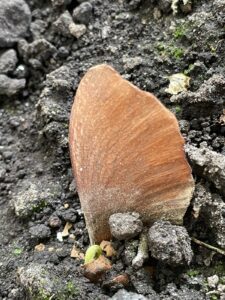

New World to Old World Migrations
During the Tertiary period, Tetrapterys and a few other related genera of the Malpighiaceae migrated north into North America and then moved east across a northern tropical corridor until reaching Europe. As temperatures cooled, the migrating Malpighiaceae moved south to central Africa where they can be found today. Other disjunct populations may have migrated later as long-distance dispersal events, but it is currently unknown how or when these most unlikely events would have occurred. While in the New World, oil-gathering bees have had a long-standing relationship with the Malpighiaceae. The disjunct populations of organisms in the Old World quickly morphed to adjust to the locally available types of bees. This demonstrates the genetic variation and morphological fluidity of this family and its ability to rapidly adapt to new circumstances. An example of this can be seen in the glands on the flowers of these species shifting from solely producing oil, to a mixed function strategy by which some glands produce oil, while others produce sugar. This has allowed the attraction of multiple potential pollinators to help ensure successful reproduction.
Early Encounters with Plant Synergies
Evidence shows early human inhabitants of South America combined tryptamine-rich seeds of the tree (Anadenanthera peregrina) with the beta-carboline-containing vine (Banisteriopsis caapi) to achieve synergistic effects analogous to the modern concept of ayahuasca (see Torres 2018). This could have happened very early in the migration process, because humans entering northern South America through the Orinoco river valley would have traversed large savannahs full of Anadenanthera peregrina, while B. caapi vines could be found growing at the edge of the zone where the savannah overlaps with the forest. It is reasonable to assume that in the search for food, both plants would have been an attractive source of nutrition for humans: water (vine) and calories (legume endosperm). Presently, some people of the Orinoco are known to chew raw caapi stems. In fact, the Piaroa, an Orinoco-based culture, still insist upon the use of Anadenanthera combined with B. caapi for the strongest effects (Rodd 2002). Cultural and ecological context would shape the recipe and method of consumption (Rodd 2008). Over time, methods have evolved, leading to the development of preparations that produce various states of consciousness associated with each respective context.
Ultimately, the use of B. caapi combined with more than one hundred potential admixture plants, became common across the eastern Andes from Bolivia, north to Colombia, and Venezuela, following the Amazon and its tributaries eastward across much of north and central Brazil. “Caapi” or “Cabi” are two of the more common names for referring to related vines across most of northern South America. B. caapi is considered by many groups of these regions to be a kind of driver of ecological ingenuity. It is the fundamental master medicinal plant teacher around which all other plants revolve.
Considering that the bulk of the vine speciation likely has occurred as a result of Andean mountain-building giving rise to novel microclimates, gravity and the physical barrier created by tall mountains would impose directionality to the spread of these species. Consequently, most migrate downstream from west to east. In Brazil, there are no verifiable occurrences of endemic Banisteriopsis relatives associated with traditional human use. For these reasons, the epicenter of the human-yagé-complex relationship is likely to be found in the upper Amazon basin at the source of the watershed.
The West Meets Caapi
For 15 years (1849 – 1864) English botanist Richard Spruce traveled upriver from the mouth of the Amazon beginning in Para, Brazil. He arrived at the upper Amazon basin (year ~1852) and traveled up the Río Negro as far north as the Orinoco (where he witnessed the chewing of caapi stems) and penetrated deep into the Río Vaupés observing and documenting the indigenous cultures (Guahibo, Tukano, and others) he encountered. From a garden plot, he collected and described Banisteria caapi (the genus later re-named Banisteriopsis) in addition to the cultural uses, rituals, etc. surrounding it. He collected a distinct variation of B. caapi with elongated swollen nodes. Spruce’s description of ayahuasca’s effects is different from modern descriptions in terms of onset and duration. The brew he encountered consisted (as far as we know) of caapi mixed with the slender lateral roots of a plant he believed was from the Apocynaceae (Iboga family), called caapi-pinima (painted caapi), a reference to the red-colored veins running through its leaves. Spruce first identified this admixture plant as a species of the genus Haemadictyon, later reclassified as Prestonia amazonica. While Spruce insisted the plant was of Aponcynaceous origin, the leaves he describes (sans red pigment) have an uncanny resemblance to Diplopterys cabrerana leaves, whose slender lateral roots combined with B. caapi stems are consumed as a decoction by the Witoto people. Not long after Spruce’s departure from South America, the rubber boom would begin, ushering in a new era of ecological degradation, cultural exploitation, and more western explorers looking for new natural resources to feed industry.
Schultes’ Enigma
Approximately 80 years after Spruce, economic botanist Richard E. Schultes was sent to the Río Vaupés to study arrow-poisons and collect new sources of rubber for industries supporting the war effort. He documented many important plants and ultimately inspired many people to become interested in ethno(sic)botany and help with the Amazonian cause. He documented and collected 2 different yellow-flowered, Malpighiaceous vines belonging to the caapi complex. Both B. martiniana (Isotype of Banisteriopsis martiniana (A.Juss.) Cuatrec. var. subenervia Cuatrec.) and the type collection of B. cabrerana (syn. D. cabrerana) were procured from tributaries of the Río Vaupés. Schultes made an effort to identify the painted caapi (Prestonia amazonica). Ultimately, he eliminated Prestonia amazonica (or any Apocynaceae) from the list of possible candidates of important admixtures to the caapi brew. However, he was unable to definitively ID Spruce’s painted caapi, ascribing this moniker to a species of Tetrapterys instead. He referenced at least 30 kinds of (known) named varieties of caapi in the NW Amazon. However, Schultes was baffled by the local indigenous people’s ability to identify different varieties of B. caapi consistently, even at a great distance without touching, smelling, or tasting the vine, whereas he was unable to distinguish them. This has been dubbed “Schultes’ Enigma”.
“This aspect of ethnobotanical studies certainly requires much more intensive and interdisciplinary field research. Are these kinds, different age forms; are they due to hardly perceptible soil or other ecological factors; are they the result of growing in semi-open or secondary situations, as opposed to the dense forest; are the specimens taken from various parts of the liana, are the cultivated specimens specially selected clones with varying chemical composition and, consequently, varying physiological effects; or are they chemovars?” (See Schultes, 1986)

Origins of the Modern Brew
Some of the writings by Schultes and other researchers, as well as herbarium collections from eastern Ecuador reference the Payaguaje family lineage (and related branches, see Payaguaje 1990 and 2007). They are amongst many notable aboriginal families of the region. When researching the roots of the ayahuasca tradition, all indications seem to converge upon the area between the Río Aguarico and the Río Putumayo as a major region of diversity. The Tukanoan cultural areas on the upper Río Negro in Colombia would be another epicenter of diversity. Additionally, researcher Gale Highpine, places the origin of ayahuasca (in the popular form known today) in the Northwest Amazon where the Río Napo meets the Amazon River.

Due to a host of factors that are political, ecological, and cultural, for the last several decades it has been relatively easy for western explorers to access Ecuador. Since the vines cared for by these Ecuadorian indigenous families (who have a long-standing, well-established relationship with these plants and have handed them down person to person over many generations), they can be seen as a kind of reference standard against which other vines can be compared. Consider the northwest Amazon basin nestled up against the eastern Andes as the epicenter with spokes radiating mostly to the east and south of that point. The logic here is that the discovery and refinement of the technology we know today as modern yagé or ayahuasca, was born in this epicenter and then slowly spread downriver and traversed the eastern slopes of the Andes. The implication is that most vines found further away from this region are derivations of the legacy vines and their hybrids originating at the epicenter. By cataloguing the attributes of legacy vines and their ethno-categories, a reference can be built for determining the pedigree of any vine of The Yagé Complex, a term that can be used to refer to the numerous named cultivated varieties of Banisteriopsis caapi and related Malpighiaceous vines incorporated in yagé/ayahuasca preparations with analogous effects. B. caapi members of The Yagé Complex can be categorized according to four fundamental morphological features of these related plants: they have either smooth or swollen nodes; they grow as either low bushes or high climbing vines. There are many hybrids that intergrade within these four features, sharing characteristics that result in new cultivars.

The Payaguaje Collection of Legacy Vines
Flower color and structure are important macroscopic features for identifying cultivars of B. caapi. Ayahuasca typically has flowers with pink petals that fade to white or creamy yellow when old, yet great variation exists. From the Río Aguarico of Ecuador has come a very special collection of vines that serve as a reference for The Yagé Complex. E. Jean Langdon’s work describes the people from this region who identify as Siekopai and speak the Paicoca language. Linguistic evidence links three of these legacy vines (tara, tzinca and wai yagé) to this region of Ecuador in Sucumbíos Province. The tara vine (which means bone in Paicoca) has long straight stem growth, smooth nodes and a flower with mauve petals that fade to white. The name may be a reference to the long slender portion of a human bone (diaphysis). According to Jonathon Miller Weisberger (in an accompanying Microcosms article), when tara yagé is prepared, the stems are pounded until the outer bark is completely removed and what remains resembles the inner part of the bone. According to Weisberger, tara yagé is so powerful that it is both cultivated and prepared far away from the community following strict protocols. The tzinca vine has large swollen nodes and white flower petals with a pink splotch running through the middle. It is also known for producing strong physical effects in those who drink it such as shaking and purging. Tzinca in the Paicoca language refers to the bulbous ends of a human long bone (epiphysis) alluding to the large swollen nodes of this vine. Wai yagé grows as a mounded shrub with flowers, similar to “Tzinca”. Weisberger relates that the word “Wai” refers to meat, fish or game in general. This vine is prepared and ingested close to home, sometimes uncooked without additional admixtures (elaborated in a way similar to how kavakava is prepared in the Pacific islands). Wai yagé is consumed for the purpose of tracking the activities of animals. Branches and leaves of “yagé oco” are often added to one or more of the previously mentioned vines to produce “yagé”. The Payaguaje legacy vines, along with many related medicinal plants were collected with permission and encouraged to be spread and consumed. Various parts of the collection have made their way to the US mainland and Hawaii and are now grown across the southern US. The clearest message disseminated with this collection (across time and cultures) is, “keep drinking”. None of the plants in this collection are for sale, and each plant has been shared lovingly from the hands of one gardener to another the way it has been for millennia. It is in this spirit that confocal images of these plants from The Yagé Complex appear in this ecodigital repository that constitutes Microcosms: A Homage to Sacred Plants of the Americas.

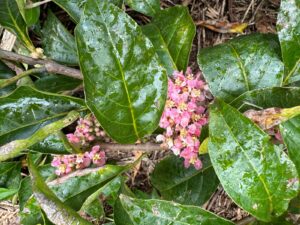
Caapi by Any Other Name…
Most westerners understand ayahuasca as simply orally-activated dmt, with the vine merely serving to supply this function. Westerners tend to look for and expect certain effects from encounters with “psychedelics” (of which yagé is considered a member). For this reason, there is a focus on the dmt-containing plants. However, it’s important for western enthusiasts of ayahuasca to remember that, regardless which of the more than a hundred potential admixture plants are added to the brew, it’s still referred to by the name of the vine called ayahuasca or yagé. The name of the brew thus reflects its primary ingredient. Spruce’s notes demonstrate there were different recipes for the brew for different purposes and by different people. Documentation of those early encounters by westerners consistently report B. caapi as the principal ingredient.
Resolving the Enigma
The original materials that best exemplify a species concept are referred to as the type and lectotype. Brazilian botanists working on Banisteriopsis caapi and its ethnotaxonomic varieties have only recently resolved these fundamental elements of species taxonomy (See de Oliveira et al and de Souza et al). Furthermore, vines from many genera of the neotropical Malpighiaceae are known to be used by people for traditional medicine and/or known to contain bioactive compounds. Examples of these genera include: Alicia, Bronwenia, Hirae, Tetrapterys, Banisteriopsis, Diplopterys, Callaeum, Mezia, Heteropterys, Glicophyllum, Stygmaphyllon, and others. The neotropical Malpighiaceae have been in taxonomic revision since the 1980’s and are expected to continue being researched and assessed for some time to come.

The difficulty of segregating these vines was, precisely, the enigma faced by Schultes. He was a botanist who collected and correctly identified thousands of plants in hyper-diverse tropical rainforests and yet these particular vines still confounded him. Botanists (Anderson and Gates) only recognize B. caapi as a single taxon with no botanically-valid varieties. Indigenous cultures and academics and preparers affiliated with the Santo Daime church in Brazil (see Monteles) have named varieties that number in the dozens. To segregate the two main varieties tucunacá (smooth nodes) and caupuri (swollen nodes) from one another, scientists have resorted to using light microscopes to peer into palisade parenchyma cells and vascular bundles. These botanists are only surveying morphological features such as flowers, leaves, bark, growth habit, microscopic cellular structure, etc., whereas the other groups (indigenous cultures and entheogenic churches in Brazil) have more experiential ways of knowing and categorizing that, in addition to morphology, can include sap color, number of lobes in the cross section of a stem, flavor, scent of leaves, physical and psycho-spiritual effects, amongst other characteristics. According to Schultes, their identity “depends on the conjunction of botanical features, chemical effects of the mode of preparation and cultural suggestions in the visions experienced.” Each cultivar is known to have their own unique effects and context for use, which are often intertwined with their respective rituals.
“Each plant has a spiritual guardian and a shaman owner, and shamans often trade kinds. Furthermore, if a shaman finds a wild liana in the forest, he will prepare a drink to ascertain its worth for inclusion in his own repertoire, especially in regard to what visions it can induce; if he takes a cutting, he will then and there name and classify it [….] Further exploration between this conjunction of botany-chemistry-culture warrants further investigation [….] It is still an enigma.” (Schultes 1986)
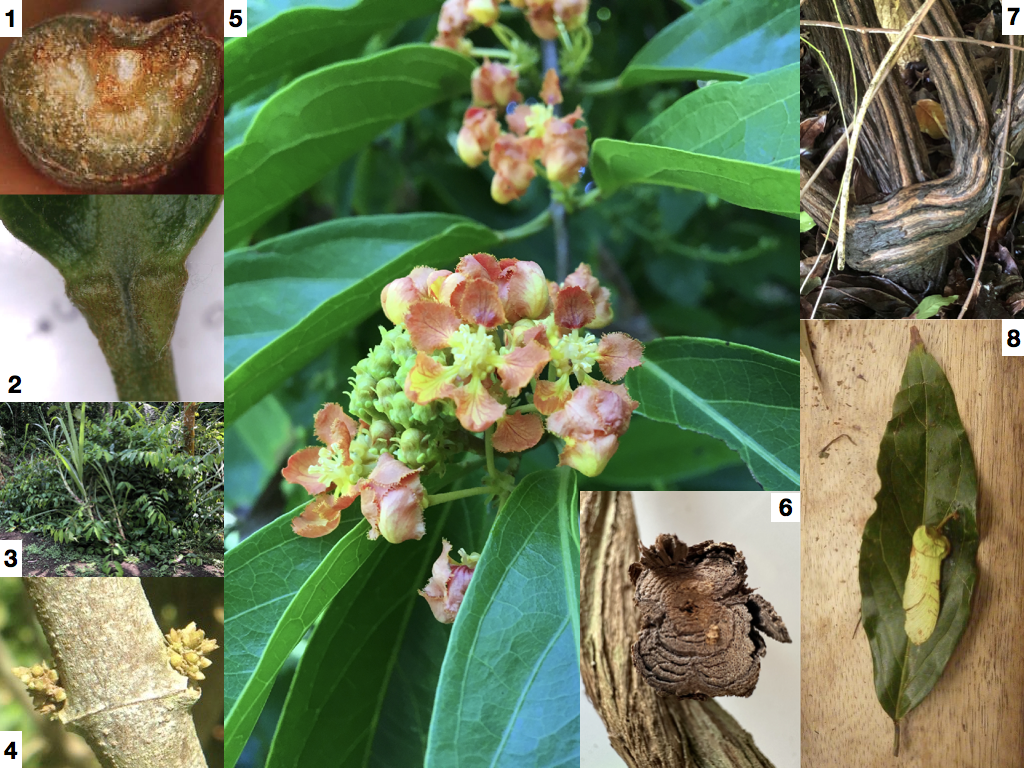
All-in-One Vine
It has long been hypothesized there may have been an original proto-vine that contained beta-carboline and tryptamine alkaloids all in a single, easy-to-consume-plant (something akin to Psilocybe mushrooms). During his search for caapi-pinima, Schultes consumed a cold water extraction of bark scrapings from Tetrapterys methystica and collected samples of the plant source. Much of his collection was lost but some was salvaged. The fragments that are left seem to indicate another epithet: Glicophyllum stylopterum (A.Juss.) R.F.Almeida. Little is known about this species from modern research. However, in Brazil, a closely- related species that is considered another kind of cabi, T. mucronata, recently has been investigated because Brazilian churches there are currently using it. The chemistry is such that it could be used as the sole ingredient in an ayahuasca-like preparation. The presences of 5Meo-DMT, 5Meo-n-methyl-typtamine, bufotenine, and 2-methyl-6-methoxy-1,2,3,4-tetrahydro-β-carboline have been detected in this species. It is considered to be something only for specialists because it is potentially very dangerous due to possible cardio-activity (Queiroz 2013).
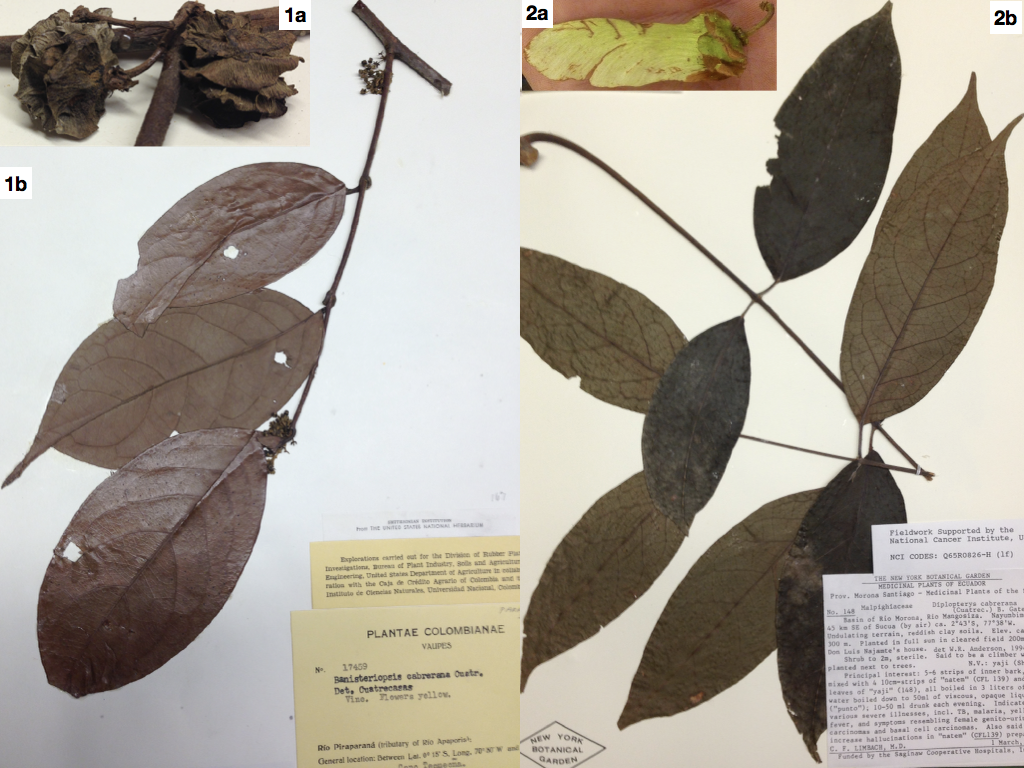
Diplopterys cabrerana Confusion
Another candidate for the all-in-one brew would seem to come from B. rusbyana (syn. D. longialata). This vine has long been conflated with Diplopterys cabrerana and appears to be the more commonly-employed admixture of the two in modern brews. There are herbarium collections of this species indicating that the trunk can be used to prepare a beverage (See Velarde-Núñez). Phytochemical analysis of this species found dmt in the leaves and bark as well as 2-methyl-tetrahydro-beta-carboline in the branches and trunk bark. Experience with this brew (where all parts of this vine are used) indicate the flavor is putrid and undrinkable, leading to the hypothesis that someone, somewhere along the way, figured out that the leaves of this vine (D. longialata) could be mixed with the bark that is relatively sweet-tasting (at least in comparison to that of B. rusbyana bark) of B. caapi, to produce a palatable tea. Might this explain how the modern yagé brew was born? This major technological advancement could have catalyzed the recent usage of caapi since a wide range of people could accept the flavor of this brew. Additionally, the National Cancer Institute (USA) funded a project in Ecuador led by C. F. Limbach in which two of their collections (“natem” B. caapi and “yaji” D. longialata) brewed together and reduced to a concentrated liquid extract is consumed to treat “various severe illness, incl. TB, malaria, yellow fever, and symptoms resembling female genitourinary carcinomas and basal cell carcinomas” (See Limbach, herbarium specimen, NYBG).
The strong morphological similarities between D. longialata and D. cabrerana and their ethnomedicinal uses have made proper collection and identification of the two very difficult. Their frequent usage keeps them in a near perpetual state of vegetative growth. For this reason, the vines rarely flower or reproduce, making their identification next to impossible.
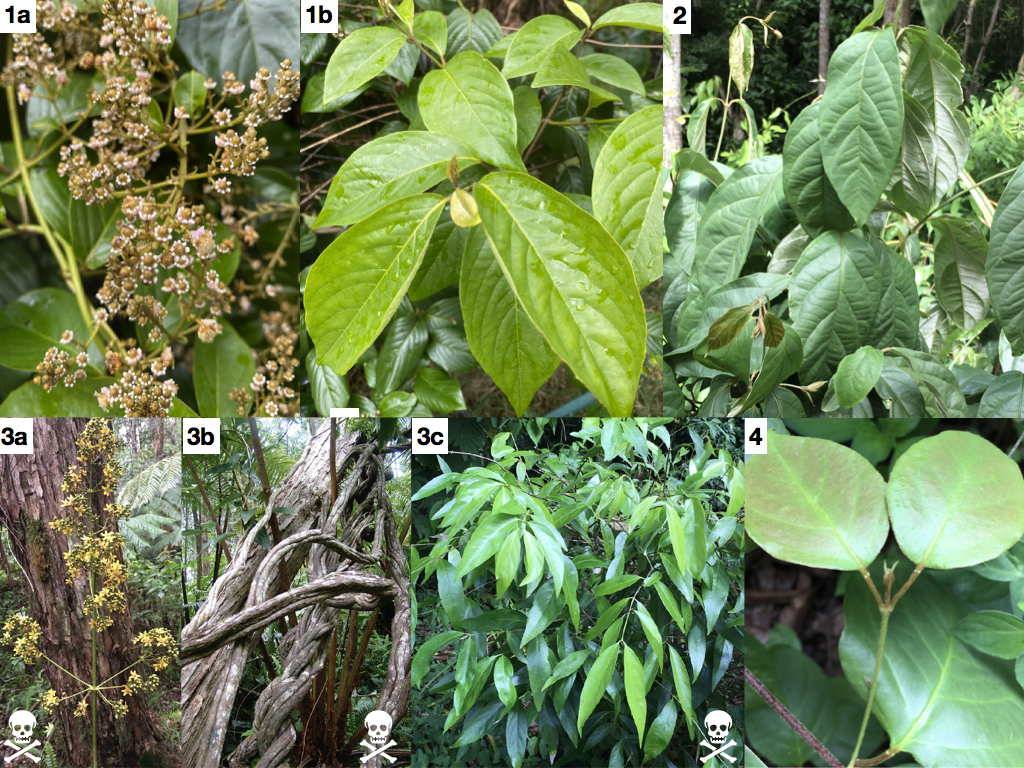
Other Vines to Know
The pressure due to overharvesting of traditional B. caapi is now so great that alternative (back up) sources are being sought. D. pubipetala has become popular in recent times as an analogue of B. caapi. Its bark is considered a functional source of harmine and the plant produces compounds in the leaves that are being studied for their ability to treat cancer. Alicia anisopetala known as purgahuasca is used (like “snake head soup” made from B. caapi leaves) as a pre-ceremony cleanse. There is also a powerful vine with blue flowers (species unknown) and the “white ayahuasca” aka “Yawarpanga” which appears to be from the genus Aristolochia – in a completely different family (Aristolochiaceae) from yagé. This vine is used as a ritual emetic before ceremonies that are focused on healing drug addiction. Then there is the look-alike vine Neidenzuella stannea with leaves that could be confused with Diplopterys cabrerana and D. longialata or with Banisteriopsis muricata with shiny two-toned (discolor) leaves. This vine contains MFA (mono floro-acetate), a non-volatile compound that doesn’t boil off during the brewing process and acts as a respiratory suppressant known to kill cows! To add to the mix, R.E. Schultes wrote, “The plant Hawkesiophyton ochraceum (Cuatrec.) A.Orejuela & C.I.Orozco (syn. Juanulloa ochracea) (Solanaceae), which contains the alkaloid parquina is called Ayahuasca in the Colombian Putumayo, and is added to Banisteriopsis drinks.” Finally, Mansoa alliaceae., (Bignoniaceae), known locally as ajosacha (wild garlic), is another vine commonly added to caapi brews. Its leaves smell like garlic and are sometimes mistaken for Diplopterys cabrerana leaves. The roots are used to cleanse the body of parasites and color the brew yellow.

Supporting South American Indigenous Cultures
What is the meaning of these legacy vines outside of their cultural and ecological contexts? The situation in the Amazon is much more dire than is reflected in the media. Friends in the front-line trenches of reforestation in the Amazon and Cerrado regions of Peru and Brazil report there is only ~30% of the Amazon left intact, and only 20% of the Cerrado! Some organizations in Ecuador claim there could be complete deforestation there by 2025. The best line of defense against deforestation is to support the forest-based cultures whose identity and livelihoods are intimately intertwined with the ecosystem within which it is embedded. To his credit, rather than continuing to exact more pressure upon wild collected resources, L. Miller did plan to cultivate the vine to supply industry, which was potentially a good thing. However, patenting a culturally significant species (as his own) is certainly not appropriate. Moving forward will require shifting the current unsustainable approach to one that is more equitable and that duly honors the worldview of indigenous peoples. What’s at stake is more than any single species. With the loss of biological and cultural diversity, we collectively lose resiliency in the face of an ever-changing world. Indigenous experience points to these vines as cross-kingdom, communication technologies, instrumental to understanding and integrating with ecosystems. Tools of this kind will help us navigate the ecological catastrophe that humanity (collectively) has been creating over the past several hundred years.

Yagé is not only a miraculous plant teacher. The cultivation of B. caapi can also help regenerate forest ecosystems. Rather than allowing vines to grow haphazardly, wreaking havoc on the new ecosystems into which they are introduced, instead they can be trellised on domes with chacruna (Psychotria viridis) growing underneath. Planting vines in a system that is well managed has the potential to regenerate soil and bring back the forest. Using longstanding traditions of agroforestry, together, we can develop regenerative agroecosystems that produce raw materials to feed our supply chains. This will slow the need to further deplete intact forest ecosystems and empower indigenous people to manage their natural resource base in a manner that honors their heritage.

Conclusion
Vines of The Yagé Complex play an important ecological and cultural role in the lives of people from the Amazon basin of South America. Shaped by the forces of continental drift, subsequent mountain building and human selection, these vines contain great diversity of form and function – a caapi for every occasion. As these lianas spread out across the continent from their point of origin, many new hybrids have been created that complicate identifying the pedigree and therefore application of unidentified vines. The morphological similarities between related taxa have perplexed even expert botanists. In recent decades, that confusion has been exploited, resulting in a patent awarded to a non-indigenous person with no acknowledgement given to the people responsible for introducing the west to these organisms in the first place. Over-exploitation of wild natural resources and deforestation have become undeniably serious threats to ecosystems and cultures who have coexisted and thrived together in the Amazon for millennia. Western culture must rectify its relationship with indigenous cultures on the basis of equality and respect in order to then integrate the wisdom of yagé to avoid global ecological catastrophe.
Photos
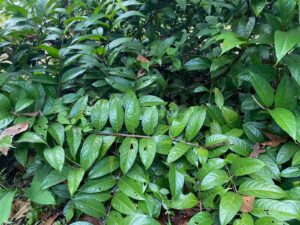

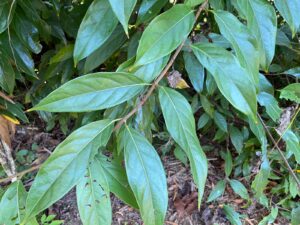
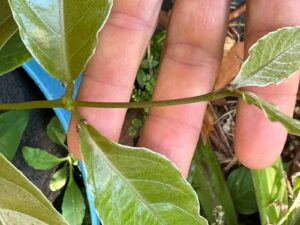
Bibliography
Davis, Charles C., Peter W. Fritsch, Charles D. Bell, and Sarah Mathews. “High Latitude Tertiary Migrations of an Exclusively Tropical Clade: Evidence from Malpighiaceae,” International Journal of Plant Sciences (Tropical Intercontinental Disjunctions) 165.S4 (July 2004): S107-S121.
Davis, Charles C. and William R. Anderson. “A Complete Generic Phylogeny of Malpighiaceae Inferred from Nucleotide Sequence Data and Morphology.” American Journal of Botany 97.12 (December 2010): 2031-2048. https://doi.org/10.3732/ajb.1000146
de Oliveira, R.C., Sonsin-Oliveira, J., dos Santos, T.A.C., Simas e Silva, M., Fagg, C.W. and Sebastiani, R. (2021), “Lectotypification of Banisteriopsis caapi and B. quitensis (Malpighiaceae), names associated with an important ingredient of Ayahuasca,” Taxon, 70: 185-188. https://doi.org/10.1002/tax.12407
de Oliveira, R.C., Behrens, C.S.B., Nagamine-Pinheiro, N. et al. “Ethnobotany and Wood Anatomy of Banisteriopsis caapi Ethnotaxa and Diplopterys cf. pubipetala, Components of Ayahuasca in Brazilian Rituals.” Economic Botany 77 (2023): 18–47. https://doi.org/10.1007/s12231-023-09567-w
de Souza, Raniely Miranda et al. “Lectotypification and neotypification of names related to Banisteriopsis caapi (Malpighiaceae): a contribution to understanding of Ayahuasca,” Phytotaxa 585.1 (2023).
Díaz León, Germán Leonardo. “NUESTRO YAJÉ… ¿TU DA VINE?: Elementos económicos, culturales y legales del debate alrededor de la propiedad intelectual sobre los Saberes Tradicionales”. Trabajo de Grado para Optar al Título de Sociólogo. Departamento de Sociología, Facultad de Ciencias Humanas, Universidad Nacional de Colombia. 20 de enero de 2006.
Gates, Bronwen. “Banisteriopsis, Diplopterys (Malpighiaceae)”. Flora Neotropica 30 (Feb. 18, 1982): 1-237. (Published by New York Botanical Garden Press on behalf of Organization for Flora Neotropica). Stable URL: https://www.jstor.org/stable/4393754
Highpine, Gayle. “Unraveling the Mystery of the Origin of Ayahuasca,” Núcleo de Estudos Interdisciplinares sobre Psicoativos (NEIP) (2012). http://neip.info/novo/wp-content/uploads/2015/04/highpine_origin-of-ayahuasca_neip_2012.pdf
Langdon, E. Jean. “Las clasificaciones del yagé dentro del grupo Siona: Etnobotánica, etnoquímica e história.” América Indígena 46 (1986): 101–116.
Limbach, M.D., C.F., Diplopterys longialata, Province of Morona Santiago, Medicinal Plants of the Shuar, No. 148 and CFL139, March 1, 1990. (Herbarium specimen at the NYBG)
Luz, Thalita Zanquetta, Antonio Saulo Cunha-Machado and Jacqueline da Silva Batista. “First DNA barcode efficiency assessment for an important ingredient in the Amazonian ayahuasca tea: mariri/jagube, Banisteriopsis (Malpighiaceae)”
Genet Resour Crop Evol (20 December 2022): https://doi. org/10.1007/s10722-022-01522-3
Miller Weisberger, Jonathon. “Rainforest Medicine, Preserving Indigenous Science and Biodiversity in the Upper Amazon” Berkeley California, North Atlantic Books, 2013
Monteles, Ricardo. “Eu venho da floresta”: A sustentabilidade das plantas sagradas amazônicas do Santo Daime. Universidade Federal do Amazonas (Manaus) (fevereiro 2020). Tese (Doutorado em Ciências do Ambiente e Sustentabilidade na Amazônia). https://tede.ufam.edu.br/bitstream/tede/7682/2/Tese_RicardoMonteles_PPGCASA.pdf
Nagamine-Pinheiro, Nívea et al. “Vegetative anatomy, morphology and histochemistry of three species of Malpighiaceae used in analogues of the Amazonian psychoactive beverage Ayahuasca,” Flora 275 (2021): https://doi.org/10.1016/j.flora.2020.151760
Payaguaje, Fernando. El bebedor de yagé. Shushufindi—Río Aguarico, Ecuador: Vicariato Apostólico de Aguarico, 1990.
_____. The Yagé Drinker. Quito: Cicame, 2007. https://rainforestmedicine.net/wp-content/uploads/2018/11/The-Yage-Drinker.pdf
Press, Sara V. “Ayahuasca on Trial: Biocolonialism, Biopiracy, and the Commodification of the Sacred.” History of Pharmacy and Pharmaceuticals 63.2 (January 2022): 328-353.
Queiroz. Marcos Marçal Ferreira “ldentificaçào dos inibidores de acetilcolinesterase em Tetrapterys mucronata Cav. (Malpighiaceae) e comparaçào quali e quantitativa dos derivados triptaminicos presentes na espécie eni estudo e Ayahuasca” Araraquara: [s.n], 2013.
Queiroz, M. M. F. et al. “Chemical Composition of the Bark of Tetrapterys mucronata and Identification of Acetylcholinesterase Inhibitory Constituents,” Journal of Natural Products 77.3 (2014): 650-656. https://doi.org/10.1021/np401003p
Queiroz, M. M. F. et al. “LC-MS/MS Quantitative Determination of Tetrapterys mucronata Alkaloids, A Plant Occasionally Used in Ayahuasca Preparation,” Phytochemical Analysis 26.3 (2015): 183-188. DOI: 10.1002/pca.2548
Schultes, Richard Evans. “Recognition of Variability in Wild Plants by Indians of the Northwest Amazon: An Enigma,” Journal of Ethnobiology 6.2 (Winter 1986): 229-238.
Spruce, Richard. “On Some Remarkable Narcotics of the Amazon Valley and Orinoco.” Ocean Highways: The Geographical Review 55.1 (1873): 184-193.
Torres, Constantino Manuel. “From Beer to Tobacco: A Probable Prehistory of Ayahuasca and Yagé,” in Dennis J. McKenna, ed. Ethnopharmacologic Search for Psychoactive Drugs: II. Santa Fe, New Mexico: Synergetic Press, 2018: 36-54.
Velarde Núñez, O. Banisteriopsis rusbyana Peru: Department of San Martin, Tarapoto Province, Tarapoto, alt. 600m. Fickle climber. Cultivated. Its trunk is used to prepare a hallucinogenic and purgative drink. N.v. “ayahuasca amarilla” 8/2/1958 O. Velarde Núñez 6589 (Herb. Morris Arb.)
Vickers, William T. Los sionas y secoyas: su adaptación al ambiente amazónico. Quito: Abya-Yala, 1989.
Vickers, William T. and Timothy Plowman. “Useful Plants of the Siona and Secoya Indians of Eastern Ecuador.” Fieldiana Botany (N.S.) 15 (1984):1–63.
Virdi, Jasmine. “The Scientific Study of Ayahuasca Ethno-Varieties with Regina Célia de Oliveira,” Chacruna Institute for Psychedelic Plant Medicines. (April 23, 2021): https://chacruna.net/botany_varieties_ayahuasca_banisteriopsiscaapi/
Werneck, Beatriz et al. “Biodiversity of β-Carboline Profile of Banisteriopsis caapi and Ayahuasca, a Plant and a Brew with Neuropharmacological Potential,” MDPI (Plants) 9. 870 (9 July 2020): doi:10.3390/plants9070870
Wiser, Glenn. “U.S. Patent and Trademark Office Reinstates Ayahuasca Patent: Flawed Decision Declares Open Season on Resources of Indigenous Peoples,” (June 25, 2001). (Author is Staff Attorney, Center for International Environmental Law).
About the Author
Neil Logan is the Innovations Officer for AgroforestryX and co-creator of the AgroforestryX design tool. AgroforestryX assists farmers, land managers, and conservation project planners to assess, design and manage dynamic multistory agroforestry systems. He is personally passionate about agro-successional restoration systems that produce medicinal, timber, and food crops to offset the costs of regenerating ecosystems. In addition to his work on Malpighiaceae, he has done extensive research on Prosopis, a summary of which can be read in the Microcosms Plant Index.
